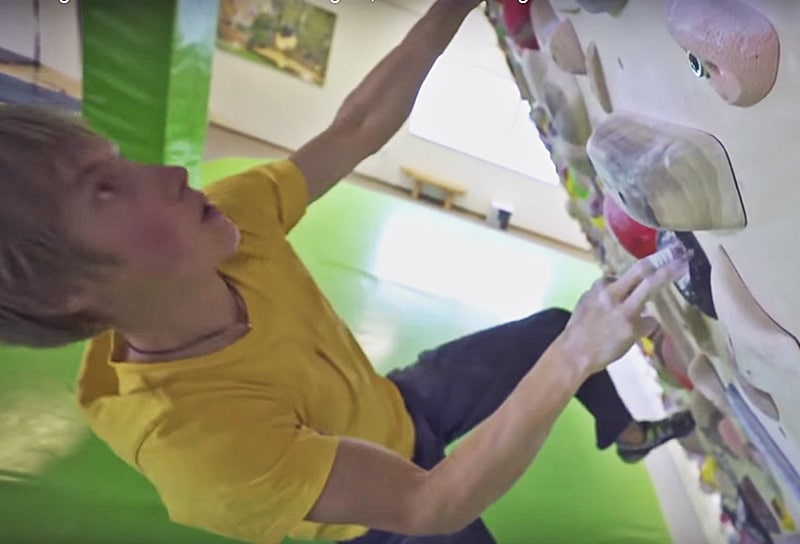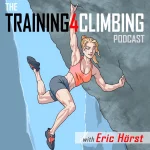
If you want to climb Zion’s classic Moonlight Buttress, you better be able to manage fatigue!
If you are serious about climbing performance, then you must be serious about managing your fatigue and accelerating recovery for more effective training.
(This article was originally published in January 2015.)
Knowing how to limit fatigue and speed recovery is just as important as knowing how to perform a drop-knee, lock a finger jam, or float a deadpoint. The bottom line: If you are not playing a proactive role in the recovery process, you are definitely not training optimally or climbing up to your capability.
Fatigue and Recovery
We all know, firsthand, that physical fatigue is a primary limiting factor whether pulling down at the crags or training in the gym. Therefore, it stands to reason that being able to accelerate recovery means you will get more back during a midclimb shakeout and while resting between climbs and days of climbing. As a result, you will perform better on the rocks today, tomorrow, and on all your future outings. Similarly, more rapid recovery between training sessions can translate into more long-term strength gains, since you can work out more often while still getting adequate rest and without risk of overtraining.
While many of today’s enthusiastic climbers are keen on staying current on the latest climbing and training techniques, surprisingly few individuals are aware of the numerous strategies for accelerating recovery. Recovery from exercise has been the subject of dozens of recent research studies, and any serious climber would be wise to heed the findings of these sports scientists. In this and future T4C articles, I will present the leading-edge recovery strategies used in these studies, as well as provide instruction on specific techniques that will help you slow fatigue and speed recovery while on the rock.
Clearly, recovery ability is a function of several factors, including age, sex, and level of conditioning. Regardless of these factors, however, I guarantee that you can recover more quickly by playing a proactive role in the recovery process—instead of just letting it happen, as many climbers do. By placing the same importance on optimal recovery as you do on training optimally, you will enhance your training response as well as your overall climbing performance!
Proactively managing fatigue and taking the steps to accelerate recovery require an understanding of the basic physiology processes involved in energy production, fatigue, and recovery. We’ll begin our primer on this subject with a look at what causes fatigue.
Causes of Fatigue
Several factors contribute to the fatigue you experience while training or climbing. These factors include the depletion of muscle fuels, the accumulation of metabolic by-products, low blood glucose, muscular cramps and microtraumas, and finally, central fatigue.
1. Depletion of ATP-CP
Adenosine triphosphate (ATP) and creatine phosphate (CP) are energy-rich phosphate compounds stored within the muscle cells in small amounts. Brief, maximum-intensity activities (such as a short, vicious boulder problem, a one-arm pull-up, or a 100-meter sprint) are fueled by ATP and CP; the supply of these fuels, however, limits this action to between five and fifteen seconds.
This limitation on maximum energy output explains why it’s next to impossible to perform double dyno campus training for more than fifteen seconds, or why you have less than fifteen seconds to pull a maximal move (for you) on a route before your muscles give out. Continued exercise beyond this time threshold is only possible by lowering the intensity of the activity, so that the anaerobic lactic energy system can contribute to energy production.
Fortunately, ATP is continually synthesized within the muscles (by little ATP factories called mitochondria), and ATP stores become fully replenished in just three to five minutes of complete rest.
2. Accumulation of Metabolic By-Products
Constant, moderately high-intensity activity that lasts between fifteen seconds and about two minutes is fueled primary by anaerobic metabolism of glycogen fuel (although the aerobic energy system also contributes to a lesser extent). Unfortunately, metabolic by-products of this energy production—chiefly, hydrogen ions (H+)—result in muscular discomfort and, eventually, muscular failure compelled by the brain in order to maintain acid-base homeostasis. How long you can exercise during periods of rising H+ concentration (decreasing pH) depends on your intra and extra-cellular buffering capacity and the efficiency of your cardiovascular at moving H+ and lactate away from the working muscles.
Anaerobic endurance training (specifically, Interval Training) will increase your tolerance to metabolic acidosis and increase mitochondria density and efficiency. Such training will increase your anaerobic power output and enable to climb harder, sustained sequences before muscular failure (which is typically after about two minutes of sustained near-maximal climbing). During rest periods, the clearance time of H+ ions (a return to acid-base homeostasis) typically takes thrity to forty-five minutes, depending on the level of acidosis and whether the rest is active or passive (more on this later).
3. Depletion of Glycogen
Sustained, steady-state exercise typically depletes glycogen stores in ninety minutes to two hours. Running out of glycogen causes the infamous hitting-the-wall phenomenon in marathon running, and is a contributing factor to building fatigue and an inability to climb hard toward the end of a long day on the rock. Fortunately, climbing is a stop-and-go activity. A full two-hour supply of glycogen can be stretched out to last nearly all day. You can also spare your glycogen supplies through regular consumption of additional fuel (sports drinks and foodstuffs) throughout the day. Research implies that carbohydrate feeding during exercise can help aid recovery by extending your glycogen supply by 25 to 50 percent.
Your starting level of glycogen is also a crucial factor in determining how long and hard you will be able to climb. If you are climbing for a second or third straight day, you will certainly have less than the full ninety-minute to two-hour supply of glycogen. This is because complete replenishment of glycogen stores takes twenty-four hours—a good dinner and a full night’s sleep is not enough to restock the supply completely. When climbing on successive days, it’s therefore vital to consume more calories throughout the day (to spare glycogen) for ongoing recovery. However, you will still likely hit the wall a bit sooner on day two than you did on day one.
4. Low Blood Glucose
Blood glucose (sugar) is but one of the possible fuel sources for working muscles, but it’s the only fuel source available to the brain and nervous system. As glycogen supplies dwindle during long-duration activity, the working muscles become increasingly reliant on blood glucose for fuel. As a result, blood glucose levels drop and increasing levels of exhaustion and mental fatigue set in. As mentioned above, ingestion of carbohydrates will help delay this fatigue and boost recovery by helping to maintain an adequate level of blood glucose.
5. Muscle Cramps and Microtraumas
Muscle cramps and microtraumas can contribute to the sense of muscular fatigue, though in somewhat different time frames. Muscle cramps typically occur near the end of an exhausting period of muscle action—for instance, when some of the muscles in your back or arms lock up after a long, strenuous section of jamming or upon reaching complete exhaustion in the midst of a long sport climb. In such an instance, twenty to thirty minutes of rest, gentle stretching and massage, as well as consuming some fluids will help alleviate the cramping and restore normal muscular function.
Microtraumas are a primary cause of the all-too-common delayed-onset muscle soreness (DOMS). No, day-after soreness is NOT from “lactic acid”! This muscle soreness, which becomes evident from twenty-four to forty-eight hours after strenuous exercise, is a result of microscopic muscle tissue tears and the accompanying tightness and swelling (edema). Strength will be diminished for as long as pain persists, possibly as long as two to five days. Use of compression garments will help reduce swelling and may help accelerate recovery.
6. Central Fatigue
In addition to muscular fatigue, strenuous exercise can have adverse affects on the central nervous system (CNS). This so-called central fatigue can impair coordination, concentration, and your ability to perform difficult motor skills. Repeated high-intensity movements such as lunging and campus training are the hardest on the CNS. However, excessive amounts of any specific training stimulus—pull-ups, fingerboard, HIT—or performing the same type of bouldering movement over and over can also produce central fatigue.
Unfortunately, severe central fatigue can take longer to recover from than any of the other causes of fatigue. Consider that recovery of a nerve cell takes up to seven times longer than a muscle cell. Of course, this level of fatigue may never be experienced by the typical recreational climber; still, elite climbers who push the envelope both in the gym and on the rock are likely to experience central fatigue. If you still feel “off” even after a few successive rest days, you may be experiencing central fatigue. It may take another two to ten days away from training and climbing to recuperate completely, but you will find yourself performing better than ever after this break away from climbing for the sake of recovery.
Related Articles:
- 10 Do’s and Don’ts for Effective Redpoint Climbing
- The Importance of Deload Weeks in Climbing and Training
- 5 Tips for Improving Your Climbing Efficiency
Copyright © 2000–2022 Eric J. Hörst | All Rights Reserved.











